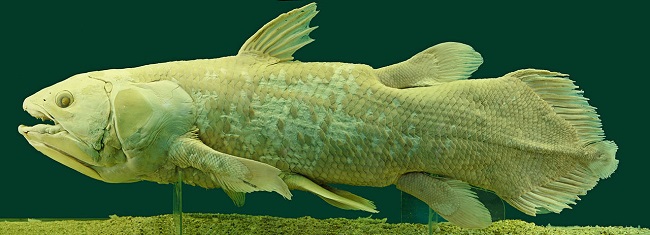
For long, coelacanths were known to science only from the fossil record and were believed to have gone extinct during the Cretaceous Period. Then, in 1938, a specimen of an extant coelacanth species (Latimeria chalumnae) was discovered among the catch of a South African fisherman. Then, in 1997, a second extant coelacanth species (L. menadoensis) was discovered by a vacationing marine biologist at an Indonesian market. These “rediscovered” species have been called “living fossils,” a term biologists argue against as it supposes that the animals have not evolved over the millennia.
Still, they do bear a striking resemblance to their very ancient relatives. It is hypothesized that their highly conserved evolution owes to their existence in a relatively unchanging deep sea environment. A lobe-finned fish, it is only a bit more removed genetically from the lungfishes and the tetrapods. In actual fact, it is more closely related to these animals than it is to ray-finned fishes.
Researchers at the Broad Institute have recently evaluated the genomes of both living coelacanth species. These were compared to that of lungfish as well as 20 other vertebrate species. While findings from these comparisons suggest that tetrapods are closer relatives to the lungfishes than they are to the coelacanths, coelacanths may still prove to be more expedient in studying the evolution of so-called higher vertebrates because of their much simpler genetic code.
More information about this study can be found at:
Broad Institute of MIT and Harvard (2013, April 17). Coelacanth genome surfaces: Unexpected insights from a fish with a 300-million-year-old fossil record. ScienceDaily. Retrieved April 23, 2013, from http://www.sciencedaily.com¬ /releases/2013/04/130417131809.htm.










0 Comments